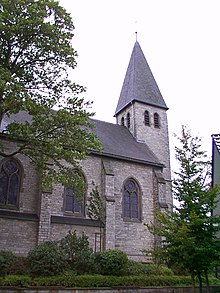St. Apollonia (Helmern)
The Catholic parish church of St. Appolonia is a church building in Helmern , a district of Bad Wünnenberg in the Paderborn district ( North Rhine-Westphalia ) that characterizes the town. The community is part of the Wünnenberg pastoral network in the Archdiocese of Paderborn .
History and architecture
The prince-bishop Ferdinand von Fürstenberg ordered the construction of a chapel in 1669 , to which patronage it was subordinated is not known.
A new building was necessary around 1880. The laying of the foundation stone on June 11, 1885 was followed by its inauguration on December 2, 1886. An organ stage was built in 1906. The parish was released from the parish of Atteln in 1920 and made an independent parish. In 1953, a boiler room was dug for heating.
A fundamental redesign of the interior was necessary in 1954 because the pulpit , confessional and pietà limited the space. Niches were let into the walls to house the Pietà and the confessional. The pulpit was placed in the choir , in which two stained glass windows with leaded glazing were installed in 1957 , Meinolfus can be seen on the right window and Apollonia on the left.
In the course of a redesign of the choir room, the flooring and the choir walls were renewed in 1971; the main altar was converted into a sacrament house. At the same time a new altar was erected. The side altars were dismantled and stone figures were installed in their place. The figures are currently hanging next to the side entrance.
In the course of a comprehensive renovation in 1980, the walls of the interior were painted, and the high altar, the organ stage, the confessional and the Way of the Cross were restored. The side altars were rebuilt and the communion bench converted into choir stalls.
In the course of the renovation in 2004, the interior was painted, the figures of saints, altars and benches were renovated and new lamps were purchased.
Furnishing
- The bells with the names Achatius and Apollonia were cast in 1886 and melted down for armament purposes during the First World War . Three new bells with the names Apollonia, Achatius and Josef were inaugurated in 1922, of which the two large ones were melted down in 1942.
- The font was made from white sandstone in 1930 and has an oak lid.
- Relics of Apollonia were given to the community in 1935 . The reliquary is displayed on certain occasions. It is currently in a wooden panel on the celebration altar .
- During a break-in in August 1949, the tabernacle was chiseled open and the monstrance inside was stolen. In November 1949 a new tabernacle and monstrance were donated.
- If necessary, the tower clock can trigger an angelus chime together with the electric bell .
- In 1960 a new organ was purchased and it was extensively renovated in 1975.
- The high altar is crowned by a cross, at the ends of which the symbols of the four evangelists are attached. In addition there are figures of Mary and John . Next to the tabernacle are two sculptural images depicting a pelican feeding its young and the Lamb of God . The lamb with the victory flag sits on a book with seven seals. Next to them are the carved figures of Saints Isaac, Melchizedek of Salem, Zacharias and John the Baptist in niches
- In the choir the figures of the Sacred Heart and the Immaculate Heart of Mary stand on pedestals.
- The statue of Apollonia is endowed with the attributes forceps and tooth
Web links
Individual evidence
- ↑ Pages of the Pastoral Association (PDF; 301 kB)
- ↑ Pages of the community
- ↑ Description of the equipment on the website of the municipality
Coordinates: 51 ° 34 ′ 12 " N , 8 ° 46 ′ 2.5" E

